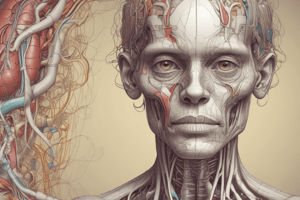Podcast
Questions and Answers
Which system transports oxygen and nutrients to cells?
Which system transports oxygen and nutrients to cells?
- Circulatory System (correct)
- Respiratory System
- Digestive System
- Nervous System
What is the main function of the Respiratory System?
What is the main function of the Respiratory System?
- Breaking down food into nutrients
- Bringing oxygen into the body and removing carbon dioxide (correct)
- Defending the body against pathogens
- Producing and regulating hormones
Which body region contains the brain, sense organs, and facial features?
Which body region contains the brain, sense organs, and facial features?
- Abdomen
- Neck
- Thorax
- Head (correct)
What is the main function of the Integumentary System?
What is the main function of the Integumentary System?
Which type of tissue forms the lining of organs and glands?
Which type of tissue forms the lining of organs and glands?
What is the term for 'front of the body'?
What is the term for 'front of the body'?
Which cavity contains the brain?
Which cavity contains the brain?
What is the term for 'closer to the point of attachment'?
What is the term for 'closer to the point of attachment'?
Flashcards are hidden until you start studying
Study Notes
Organ Systems
- Nervous System: controls and coordinates body functions, consists of Central Nervous System (CNS) and Peripheral Nervous System (PNS)
- Circulatory System: transports oxygen and nutrients to cells, consists of heart, blood vessels, and blood
- Respiratory System: brings oxygen into the body and removes carbon dioxide, consists of lungs, trachea, bronchi, and diaphragm
- Digestive System: breaks down food into nutrients, consists of mouth, esophagus, stomach, small intestine, and large intestine
- Endocrine System: produces and regulates hormones, consists of glands such as pituitary, thyroid, and adrenal glands
- Immune System: defends the body against pathogens, consists of lymphoid organs, tissues, and cells
- Muscular System: moves the body and maintains posture, consists of skeletal, smooth, and cardiac muscles
- Skeletal System: provides support and protection, consists of bones, ligaments, and tendons
- Urinary System: filters waste and excess fluids, consists of kidneys, ureters, bladder, and urethra
- Integumentary System: protects the body from external damage, consists of skin, hair, nails, and associated glands
Body Regions
- Head: contains the brain, sense organs, and facial features
- Neck: connects the head to the torso
- Thorax: contains the heart and lungs
- Abdomen: contains the digestive organs
- Pelvis: contains the reproductive organs and lower back muscles
- Upper Limb: consists of shoulder, arm, forearm, wrist, and hand
- Lower Limb: consists of hip, thigh, leg, ankle, and foot
Body Cavities
- Cranial Cavity: contains the brain
- Thoracic Cavity: contains the heart and lungs
- Abdominal Cavity: contains the digestive organs
- Pelvic Cavity: contains the reproductive organs
Tissue Types
- Epithelial Tissue: forms the lining of organs and glands
- Connective Tissue: provides support and structure
- Muscle Tissue: allows for movement and contraction
- Nervous Tissue: transmits and processes information
Directional Terms
- Anterior: front of the body
- Posterior: back of the body
- Superior: above or upper part of the body
- Inferior: below or lower part of the body
- Medial: towards the midline of the body
- Lateral: away from the midline of the body
- Proximal: closer to the point of attachment
- Distal: farther from the point of attachment
Organ Systems
- Nervous System controls and coordinates body functions, consisting of Central Nervous System (CNS) and Peripheral Nervous System (PNS)
- Circulatory System transports oxygen and nutrients to cells, comprising heart, blood vessels, and blood
- Respiratory System brings oxygen into the body and removes carbon dioxide, consisting of lungs, trachea, bronchi, and diaphragm
- Digestive System breaks down food into nutrients, consisting of mouth, esophagus, stomach, small intestine, and large intestine
- Endocrine System produces and regulates hormones, consisting of glands such as pituitary, thyroid, and adrenal glands
- Immune System defends the body against pathogens, consisting of lymphoid organs, tissues, and cells
- Muscular System moves the body and maintains posture, consisting of skeletal, smooth, and cardiac muscles
- Skeletal System provides support and protection, consisting of bones, ligaments, and tendons
- Urinary System filters waste and excess fluids, consisting of kidneys, ureters, bladder, and urethra
- Integumentary System protects the body from external damage, consisting of skin, hair, nails, and associated glands
Body Regions
- Head contains the brain, sense organs, and facial features
- Neck connects the head to the torso
- Thorax contains the heart and lungs
- Abdomen contains the digestive organs
- Pelvis contains the reproductive organs and lower back muscles
- Upper Limb consists of shoulder, arm, forearm, wrist, and hand
- Lower Limb consists of hip, thigh, leg, ankle, and foot
Body Cavities
- Cranial Cavity contains the brain
- Thoracic Cavity contains the heart and lungs
- Abdominal Cavity contains the digestive organs
- Pelvic Cavity contains the reproductive organs
Tissue Types
- Epithelial Tissue forms the lining of organs and glands
- Connective Tissue provides support and structure
- Muscle Tissue allows for movement and contraction
- Nervous Tissue transmits and processes information
Directional Terms
- Anterior refers to the front of the body
- Posterior refers to the back of the body
- Superior refers to the above or upper part of the body
- Inferior refers to the below or lower part of the body
- Medial refers to the area towards the midline of the body
- Lateral refers to the area away from the midline of the body
- Proximal refers to the area closer to the point of attachment
- Distal refers to the area farther from the point of attachment
Studying That Suits You
Use AI to generate personalized quizzes and flashcards to suit your learning preferences.




